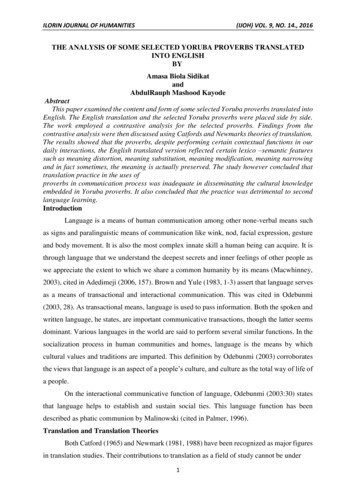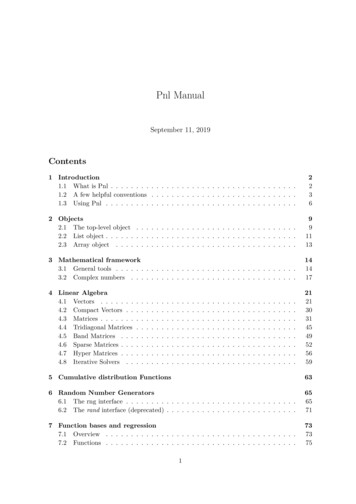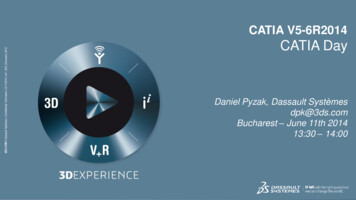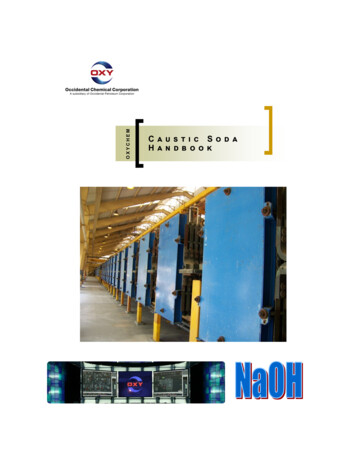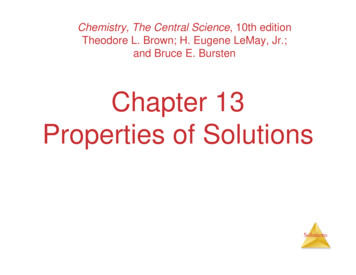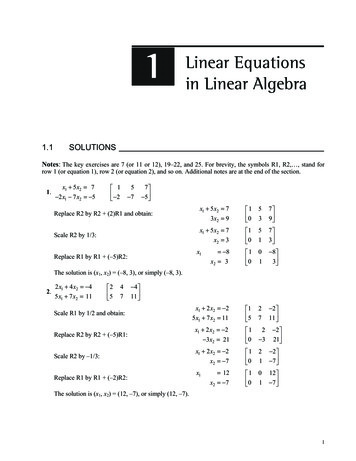
Transcription
1.1SOLUTIONSNotes: The key exercises are 7 (or 11 or 12), 19–22, and 25. For brevity, the symbols R1, R2, , stand forrow 1 (or equation 1), row 2 (or equation 2), and so on. Additional notes are at the end of the section.1.x1 5 x2 7 2 x1 7 x2 5 1 2 5 77 5 Replace R2 by R2 (2)R1 and obtain:x1 5 x2 73x2 9x1 5 x2 7Scale R2 by 1/3:x2 3x1Replace R1 by R1 (–5)R2: 8x2 3 1 0 537 9 1 0 517 3 1 0 01 8 3 1 5 27 2 11 1 0 2 3 1 0 21 2 7 1 0 0112 7 The solution is (x1, x2) (–8, 3), or simply (–8, 3).2.2 x1 4 x2 45 x1 7 x2 11 2 5 47 4 11 Scale R1 by 1/2 and obtain:Replace R2 by R2 (–5)R1:Scale R2 by –1/3:Replace R1 by R1 (–2)R2:x1 2 x2 25 x1 7 x2 11x1 2 x2 2 3x2 21x1 2 x2 2x2 7x1 12x2 7 2 21 The solution is (x1, x2) (12, –7), or simply (12, –7).1
2CHAPTER 1 Linear Equations in Linear Algebra3. The point of intersection satisfies the system of two linear equations:x1 5 x2 7x1 2 x2 2 1 1 5 27 2 Replace R2 by R2 (–1)R1 and obtain:x1 5 x2 7 7 x2 9x1 5 x2 7Scale R2 by –1/7:x2 9/7x1Replace R1 by R1 (–5)R2: 4/7x2 9/7 1 0 5 77 9 1 0 517 9/7 1 0 014/7 9/7 1 0 581 2 1 0 51 1 1/4 1 0 01The point of intersection is (x1, x2) (4/7, 9/7).4. The point of intersection satisfies the system of two linear equations:x1 5 x2 13x1 7 x2 5 1 3 5 71 5 x1 5 x2 1Replace R2 by R2 (–3)R1 and obtain:Scale R2 by 1/8:Replace R1 by R1 (5)R2:8 x2 2x1 5 x2 1x2 1/4x1 9/4x2 1/49/4 1/4 The point of intersection is (x1, x2) (9/4, 1/4).5. The system is already in “triangular” form. The fourth equation is x4 –5, and the other equations do notcontain the variable x4. The next two steps should be to use the variable x3 in the third equation toeliminate that variable from the first two equations. In matrix notation, that means to replace R2 by itssum with 3 times R3, and then replace R1 by its sum with –5 times R3.6. One more step will put the system in triangular form. Replace R4 by its sum with –3 times R3, which40 1 1 6 02 704 . After that, the next step is to scale the fourth row by –1/5.produces 0012 3 00 5 15 07. Ordinarily, the next step would be to interchange R3 and R4, to put a 1 in the third row and third column.But in this case, the third row of the augmented matrix corresponds to the equation 0 x1 0 x2 0 x3 1,or simply, 0 1. A system containing this condition has no solution. Further row operations areunnecessary once an equation such as 0 1 is evident.The solution set is empty.
1.1 Solutions38. The standard row operations are: 1 0 0 4100 10 00 0972 4100 10 00 0971 4100010 10 00 00100010 0 0 The solution set contains one solution: (0, 0, 0).9. The system has already been reduced to triangular form. Begin by scaling the fourth row by 1/2 and thenreplacing R3 by R3 (3)R4: 1 0 0 0 11000 31000 32 4 1 7 0 1 0 4 0 11000 31000 31 4 17 0 1 0 2 0 11000 3100001 4 7 5 2 Next, replace R2 by R2 (3)R3. Finally, replace R1 by R1 R2: 1 0 0 0 110000100001 4 18 0 5 0 2 00100001000014 8 5 2 The solution set contains one solution: (4, 8, 5, 2).10. The system has already been reduced to triangular form. Use the 1 in the fourth row to change the–4 and 3 above it to zeros. That is, replace R2 by R2 (4)R4 and replace R1 by R1 (–3)R4. For thefinal step, replace R1 by R1 (2)R2. 1 0 0 0 210000103 401 2 17 0 6 0 3 0 2100001000017 1 5 0 6 0 3 0010000100001 3 5 6 3 The solution set contains one solution: (–3, –5, 6, –3).11. First, swap R1 and R2. Then replace R3 by R3 (–3)R1. Finally, replace R3 by R3 (2)R2.35 2 1 3 5 2 0 1 4 5 1 3 5 2 1 1 3 5 2 0 1 4 5 014 5 0 1 4 5 3 7 76 3 7 76 0 2 8 12 0 0 02 The system is inconsistent, because the last row would require that 0 2 if there were a solution.The solution set is empty.12. Replace R2 by R2 (–3)R1 and replace R3 by R3 (4)R1. Finally, replace R3 by R3 (3)R2.4 4 1 34 4 1 34 4 1 3 3 7 7 8 02 54 02 54 46 17 0 6 15 9 0003 The system is inconsistent, because the last row would require that 0 3 if there were a solution.The solution set is empty.
4CHAPTER 1 113. 2 0 1 0 0 114. 1 0 1 0 0 Linear Equations in Linear Algebra0 321958 17 0 2 00 31051 301151 3010118 1 2 0 1 05 12 00 05 10 01 00 321155001001 30 2151 3010018 1 9 0 2 00 3125158 1 2 0 9 00 310558 2 5 5 3 . The solution is (5, 3, –1). 1 5 17 00 0 301 2150010015 1 1 01 05 10 07 0 3010175 0 7 2 1 . The solution is (2, –1, 1).1 15. First, replace R4 by R4 (–3)R1, then replace R3 by R3 (2)R2, and finally replace R4 by R4 (3)R3.0 302 10302 1 0 1 0 33010 33 0 2 321 0 2321 0 07 5 00 97 11 3 1 0 0 001300 3003 9 472 13 0 7 0 11 001300 30030 4 52 3 7 10 The resulting triangular system indicates that a solution exists. In fact, using the argument from Example 2,one can see that the solution is unique.16. First replace R4 by R4 (2)R1 and replace R4 by R4 (–3/2)R2. (One could also scale R2 beforeadding to R4, but the arithmetic is rather easy keeping R2 unchanged.) Finally, replace R4 by R4 R3. 1 0 0 2 3 1 0 0 2 3 0 2 200 0 2 200 0 0 131 0 0 131 15 0 3 2 3 1 2 3 2 1 0 0 00202 20001 13 3 3 10 0 1 0 1 00202 20001030 3 0 1 0 The system is now in triangular form and has a solution. The next section discusses how to continue withthis type of system.
1.1 Solutions517. Row reduce the augmented matrix corresponding to the given system of three equations:1 1 41 1 41 1 4 2 1 3 0 7 5 07 5 1 34 0 75 000 The system is consistent, and using the argument from Example 2, there is only one solution. So the threelines have only one point in common.18. Row reduce the augmented matrix corresponding to the given system of three equations: 1 0 12113 104 11 00 02111 1 14 11 0 4 02110 104 1 5 The third equation, 0 –5, shows that the system is inconsistent, so the three planes have no point incommon.4 h 1 h 4 119. Write c for 6 – 3h. If c 0, that is, if h 2, then the system has no 3 6 8 0 6 3h 4 solution, because 0 cannot equal –4. Otherwise, when h 2, the system has a solution.h 3 1 h 3 120. . Write c for 4 2h. Then the second equation cx2 0 has a solution 6 0 4 2h 0 2 4for every value of c. So the system is consistent for all h.3 2 1 3 2 121. . Write c for h 12. Then the second equation cx2 0 has a solution 8 0 h 12 0 4 hfor every value of c. So the system is consistent for all h. 2 3 h 222. 9 5 0 6if h –5/3. 30h . The system is consistent if and only if 5 3h 0, that is, if and only5 3h 23. a. True. See the remarks following the box titled Elementary Row Operations.b. False. A 5 6 matrix has five rows.c. False. The description given applied to a single solution. The solution set consists of all possiblesolutions. Only in special cases does the solution set consist of exactly one solution. Mark a statementTrue only if the statement is always true.d. True. See the box before Example 2.24. a. True. See the box preceding the subsection titled Existence and Uniqueness Questions.b. False. The definition of row equivalent requires that there exist a sequence of row operations thattransforms one matrix into the other.c. False. By definition, an inconsistent system has no solution.d. True. This definition of equivalent systems is in the second paragraph after equation (2).
6CHAPTER 1 Linear Equations in Linear Algebra7 g 1 47g 1 47g 1 4 25.3 5 h 03 5h 03 5h 0 25 9 k 0 35 k 2 g 000 k 2 g h Let b denote the number k 2g h. Then the third equation represented by the augmented matrix aboveis 0 b. This equation is possible if and only if b is zero. So the original system has a solution if and onlyif k 2g h 0.26. A basic principle of this section is that row operations do not affect the solution set of a linear system.Begin with a simple augmented matrix for which the solution is obviously (–2, 1, 0), and then performany elementary row operations to produce other augmented matrices. Here are three examples. The factthat they are all row equivalent proves that they all have the solution set (–2, 1, 0). 1 0 0001001 2 11 20 0001001 2 1 3 20 2001001 2 3 4 27. Study the augmented matrix for the given system, replacing R2 by R2 (–c)R1: 1 c3df 1 g 03d 3cf g cf This shows that shows d – 3c must be nonzero, since f and g are arbitrary. Otherwise, for some choicesof f and g the second row would correspond to an equation of the form 0 b, where b is nonzero.Thus d 3c.28. Row reduce the augmented matrix for the given system. Scale the first row by 1/a, which is possiblesince a is nonzero. Then replace R2 by R2 (–c)R1. a c bdf 1 g cb/adf / a 1 g 0b/ad c(b / a)f /a g c( f / a ) The quantity d – c(b/a) must be nonzero, in order for the system to be consistent when the quantityg – c( f /a) is nonzero (which can certainly happen). The condition that d – c(b/a) 0 can also be writtenas ad – bc 0, or ad bc.29. Swap R1 and R2; swap R1 and R2.30. Multiply R2 by –1/2; multiply R2 by –2.31. Replace R3 by R3 (–4)R1; replace R3 by R3 (4)R1.32. Replace R3 by R3 (3)R2; replace R3 by R3 (–3)R2.33. The first equation was given. The others are:T2 (T1 20 40 T3 )/4,or4T2 T1 T3 60T3 (T4 T2 40 30)/4,or4T3 T4 T2 70T4 (10 T1 T3 30)/4,or4T4 T1 T3 40
1.1 Solutions7Rearranging,4T1 T1 T24T2 T2 T3 4T3 T3 T1T4 T4 4T4 3060704034. Begin by interchanging R1 and R4, then create zeros in the first column: 4 1 0 1 14 10 10 140 14 130 160 1 70 0 40 4 1 14004 1 140 1 140 160 0 70 0 30 004 1 1 104 4440 420 1 70 15 190 Scale R1 by –1 and R2 by 1/4, create zeros in the second column, and replace R4 by R4 R3: 1 0 0 001 1 1 4 1 115104 4 40 15 0 70 0 190 00100104 4 4 1 214 40 15 0 75 0 195 001001040 4 1 212 40 5 75 270 Scale R4 by 1/12, use R4 to create zeros in column 4, and then scale R3 by 1/4: 1 0 0 001001040 4 1 21 40 15 0 75 0 22.5 001001040000150 127.5 0 120 0 22.5 001001010000150 27.5 30 22.5 The last step is to replace R1 by R1 (–1)R3: 1 0 0 001000010000120.0 27.5 . The solution is (20, 27.5, 30, 22.5).30.0 22.5 Notes: The Study Guide includes a “Mathematical Note” about statements, “If , then .”This early in the course, students typically use single row operations to reduce a matrix. As a result, eventhe small grid for Exercise 34 leads to about 25 multiplications or additions (not counting operations withzero). This exercise should give students an appreciation for matrix programs such as MATLAB. Exercise 14in Section 1.10 returns to this problem and states the solution in case students have not already solved thesystem of equations. Exercise 31 in Section 2.5 uses this same type of problem in connection with an LUfactorization.For instructors who wish to use technology in the course, the Study Guide provides boxed MATLABnotes at the ends of many sections. Parallel notes for Maple, Mathematica, and the TI-83 /86/89 and HP-48Gcalculators appear in separate appendices at the end of the Study Guide. The MATLAB box for Section 1.1describes how to access the data that is available for all numerical exercises in the text. This feature has theability to save students time if they regularly have their matrix program at hand when studying linear algebra.The MATLAB box also explains the basic commands replace, swap, and scale. These commands areincluded in the text data sets, available from the text web site, www.laylinalgebra.com.
8CHAPTER 11.2 Linear Equations in Linear AlgebraSOLUTIONSNotes: The key exercises are 1–20 and 23–28. (Students should work at least four or five from Exercises7–14, in preparation for Section 1.5.)1. Reduced echelon form: a and b. Echelon form: d. Not echelon: c.2. Reduced echelon form: a. Echelon form: b and d. Not echelon: c. 13. 4 6 14. 3 52573684 17 09 02 3 5 1 0 02103204 13 00 03577 19 01 03 4 8579 1 0 03105207 13 01 0 5. 0* , 0* 0,0 0 17. 3397 1 6 0473 6 100105 8 163104 1 9 0 15 0 12031 80 10 01 0010 6. 0 0 0 304 57 1 15 0Corresponding system of equations:4 3 15 32 10 2 3 . Pivot cols 1 and 2.0 7 1 12 0 34 052021 530x1 3x2x33100 Pivot cols0 .1, 2, and 41 * , 00 0412577 13 0 34 052 16 120 1 4 6* 00 , 00 07 1 3 04 7 9 368520 1 3 57 3 10 3557797 9 1 0 0 3001 5 3 5 3The basic variables (corresponding to the pivot positions) are x1 and x3. The remaining variable x2 is free.Solve for the basic variables in terms of the free variable. The general solution is x1 5 3x2 x2 is free x 3 3Note: Exercise 7 is paired with Exercise 10.
1.2 18. 2477 1 10 0004 17 1 4 000Corresponding system of equations:417 1 4 0000100 Solutions9 9 4 9 4x1x2The basic variables (corresponding to the pivot positions) are x1 and x2. The remaining variable x3 is free.Solve for the basic variables in terms of the free variable. In this particular problem, the basic variablesdo not depend on the value of the free variable. x1 9 General solution: x2 4 x is free 3Note: A common error in Exercise 8 is to assume that x3 is zero. To avoid this, identify the basic variablesfirst. Any remaining variables are free. (This type of computation will arise in Chapter 5.) 09. 11 2 675 1 6 0Corresponding system: 21x1x27 6 6 1 5 0 5 x3 4 6 x3 501 5 64 5 x1 4 5 x3 Basic variables: x1, x2; free variable: x3. General solution: x2 5 6 x3 x is free 3 110. 3 2 6 1 2 203 1 2 0Corresponding system:x1 113 1 7 0 2 x2 2001 4 7 4x3 7 x1 4 2 x2 Basic variables: x1, x3; free variable: x2. General solution: x2 is free x 7 3 311. 9 6 42128 6 40 30 00 0x1Corresponding system: 420000 4x230 10 00 0 4 / 32/300002x330 00 0 00 0 0
10CHAPTER 1 Linear Equations in Linear Algebra42 x1 3 x2 3 x3 Basic variable: x1; free variables x2, x3. General solution: x2 is free x is free 3 112. 0 1 706071 4 225 1 3 07 0x1 706001 4 28 7 x2x3Corresponding system:5 1 3 012 0 7060010 205 3 0 6 x4 5 2 x4 30 0 x1 5 7 x2 6 x4 x is free Basic variables: x1 and x3; free variables: x2, x4. General solution: 2 x3 3 2 x4 x4 is free 1 013. 0 0 31000000 1010 2 11 0 4 0 0 00 490 3100x1Corresponding system:x2x4000000109 490 3x5 5 4 x5 9 x5 1 42 11 0 4 0 0 0010000000 0 x1 5 3x5 x 1 4x5 2Basic variables: x1, x2, x4; free variables: x3, x5. General solution: x3 is free x 4 9x5 4 x5 is freeNote: The Study Guide discusses the common mistake x3 0. 1 014. 0 021 5 6 6 30000000010 5 12 0 0 0 0 0017 60 30000000010 9 2 0 0 0010 3 4905 1 4 0
1.2 7 x3x1Corresponding system:x2 6 x3 Solutions 9 3 x4 200 0x5 x1 9 7 x3 x 2 6 x 3x34 2Basic variables: x1, x2, x5; free variables: x3, x4. General solution: x3 is free x is free 4 x5 015. a. The system is consistent, with a unique solution.b. The system is inconsistent. (The rightmost column of the augmented matrix is a pivot column).16. a. The system is consistent, with a unique solution.b. The system is consistent. There are many solutions because x2 is a free variable. 217. 436h 2 7 030h The system has a solution only if 7 – 2h 0, that is, if h 7/2.7 2h 3 2 1 3 2 1 18. If h 15 is zero, that is, if h –15, then the system has no solution, h 7 0 h 153 5because 0 cannot equal 3. Otherwise, when h 15, the system has a solution.h2 1 h 2 119. 4 8 k 0 8 4h k 8 a. When h 2 and k 8, the augmented column is a pivot column, and the system is inconsistent.b. When h 2, the system is consistent and has a unique solution. There are no free variables.c. When h 2 and k 8, the system is consistent and has many solutions.32 1 3 2 120. 3 h k 0 h 9 k 6 a. When h 9 and k 6, the system is inconsistent, because the augmented column is a pivot column.b. When h 9, the system is consistent and has a unique solution. There are no free variables.c. When h 9 and k 6, the system is consistent and has many solutions.21. a.b.c.d.e.False. See Theorem 1.False. See the second paragraph of the section.True. Basic variables are defined after equation (4).True. This statement is at the beginning of Parametric Descriptions of Solution Sets.False. The row shown corresponds to the equation 5x4 0, which does not by itself lead to acontradiction. So the system might be consistent or it might be inconsistent.11
12CHAPTER 1 Linear Equations in Linear Algebra22. a. False. See the statement preceding Theorem 1. Only the reduced echelon form is unique.b. False. See the beginning of the subsection Pivot Positions. The pivot positions in a matrix aredetermined completely by the positions of the leading entries in the nonzero rows of any echelonform obtained from the matrix.c. True. See the paragraph after Example 3.d. False. The existence of at least one solution is not related to the presence or absence of free variables.If the system is inconsistent, the solution set is empty. See the solution of Practice Problem 2.e. True. See the paragraph just before Example 4.23. Yes. The system is consistent because with three pivots, there must be a pivot in the third (bottom) rowof the coefficient matrix. The reduced echelon form cannot contain a row of the form[0 0 0 0 0 1].24. The system is inconsistent because the pivot in column 5 means that there is a row of the form[0 0 0 0 1]. Since the matrix is the augmented matrix for a system, Theorem 2 shows that the systemhas no solution.25. If the coefficient matrix has a pivot position in every row, then there is a pivot position in the bottomrow, and there is no room for a pivot in the augmented column. So, the system is consistent, byTheorem 2.26. Since there are three pivots (one in each row), the augmented matrix must reduce to the formx1 a 1 0 0 a 0 1 0 b and so bx2 0 0 1 c x3 cNo matter what the values of a, b, and c, the solution exists and is unique.27. “If a linear system is consistent, then the solution is unique if and only if every column in the coefficientmatrix is a pivot column; otherwise there are infinitely many solutions. ”This statement is true because the free variables correspond to nonpivot columns of the coefficientmatrix. The columns are all pivot columns if and only if there are no free variables. And there are no freevariables if and only if the solution is unique, by Theorem 2.28. Every column in the augmented matrix except the rightmost column is a pivot column, and the rightmostcolumn is not a pivot column.29. An underdetermined system always has more variables than equations. There cannot be more basicvariables than there are equations, so there must be at least one free variable. Such a variable may beassigned infinitely many different values. If the system is consistent, each different value of a freevariable will produce a different solution.30. Example:x12 x1 x2 2 x2 x3 4 2 x3 531. Yes, a system of linear equations with more equations than unknowns can be consistent.x1 x2 2x2 0Example (in which x1 x2 1): x1 3x1 2 x2 5
1.2 Solutions1332. According to the numerical note in Section 1.2, when n 30 the reduction to echelon form takes about2(30)3/3 18,000 flops, while further reduction to reduced echelon form needs at most (30)2 900 flops.Of the total flops, the “backward phase” is about 900/18900 .048 or about 5%.When n 300, the estimates are 2(300)3/3 18,000,000 phase for the reduction to echelon form and(300)2 90,000 flops for the backward phase. The fraction associated with the backward phase is about(9 104) /(18 106) .005, or about .5%.33. For a quadratic polynomial p(t) a0 a1t a2t2 to exactly fit the data (1, 12), (2, 15), and (3, 16), thecoefficients a0, a1, a2 must satisfy the systems of equations given in the text. Row reduce the augmentedmatrix: 1 1 11 12 14 15 09 16 0123 1 0 01010011 12 133 084 011213 16 0 1 000100112 13 0 2 0111032 a4 0411103112 3 1 7 6 1 The polynomial is p(t) 7 6t – t2.34. [M] The system of equations to be solved is:a0 a1 0 a2 0 2 a3 032 a3 23 a3 43 3a0 a1 2 a2 2a0 a1 4 a2 42 2a0 a1 6a1 8a2 6 a2 82a0 a0 a1 10 a2 102 a3 63a3 8 a3 103 a5 05 a4 24 a5 25 2.90 a4 44 a5 45 14.8 a4 64 5 39.6a4 845 74.3 a4 104a5 6 a5 8 a5 105 0119The unknowns are a0, a1, , a5. Use technology to compute the reduced echelon of the augmentedmatrix: 1 0 1 2 1 4 1 6 1 8 1 10 1 0 0 0 0 80032960480026880902400 12.9 0 14.8 0 39.6 074.3 0 119 00 12.9 0 9 0 3.9 08.7 0 14.5 92003296048007680422400 2.9 9 30.9 62.7 104.5 0 2.9 9 3.9 6.9 24.5
14CHAPTER 1 Linear Equations in Linear Algebra 1 0 0 0 0 40 1 0 0 0 0 00200000480000848480001622457638400000010 12.9 0 9 0 3.9 0 6.9 0 10 0020000048000084848000 1 02.8167 06.5000 " 8.6000 0 0 26.900 .002604 0010000001000016224576384000010000001000 322.9 9609 48003.9 7680 6.9 1 .0026 0000010 1.7125 1.1948 .6615 .0701 .0026 Thus p(t) 1.7125t – 1.1948t2 .6615t3 – .0701t4 .0026t5, and p(7.5) 64.6 hundred lb.Notes: In Exercise 34, if the coefficients are retained to higher accuracy than shown here, then p(7.5) 64.8.If a polynomial of lower degree is used, the resulting system of equations is overdetermined. The augmentedmatrix for such a system is the same as the one used to find p, except that at least column 6 is missing. Whenthe augmented matrix is row reduced, the sixth row of the augmented matrix will be entirely zero except for anonzero entry in the augmented column, indicating that no solution exists.Exercise 34 requires 25 row operations. It should give students an appreciation for higher-levelcommands such as gauss and bgauss, discussed in Section 1.4 of the Study Guide. The command ref(reduced echelon form) is available, but I recommend postponing that command until Chapter 2.The Study Guide includes a “Mathematical Note” about the phrase, “If and only if,” used in Theorem 2.1.3SOLUTIONSNotes: The key exercises are 11–14, 17–22, 25, and 26. A discussion of Exercise 25 will help studentsunderstand the notation [a1 a2 a3], {a1, a2, a3}, and Span{a1, a2, a3}. 1 3 1 ( 3) 4 1. u v . 2 1 2 ( 1) 1 Using the definitions carefully, 1 3 1 ( 2)( 3) 1 6 5 u 2 v ( 2) , or, more quickly, 2 1 2 ( 2)( 1) 2 2 4 1 3 1 6 5 u 2v 2 . The intermediate step is often not written. 2 1 2 2 4 3 2 3 2 5 2. u v . 2 1 2 ( 1) 1 Using the definitions carefully,
1.3 Solutions 3 2 3 ( 2)(2) 3 ( 4) 1 u 2 v ( 2) , or, more quickly, 2 1 2 ( 2)( 1) 2 2 4 3 2 3 4 1 u 2v 2 . The intermediate step is often not written. 2 1 2 2 4 3.x2u – 2vu–vu– 2vu v–vx1v4.u – 2vx2u–vu– 2vu v–vx1v 6 x1 3 x2 1 6 3 1 5. x1 1 x2 4 7 , x1 4 x2 7 , 5 x1 0 5 5 0 5 6 x1 3x2 1 x1 4 x2 75 x1 5 6 x1 3x2 1 x 4 x 7 2 1 5 x1 5 Usually the intermediate steps are not displayed. 2 8 1 0 6. x1 x2 x3 , 3 5 6 0 2 x2 8 x2 x3 3x1 5 x2 6 x3 2 x1 8 x2 x3 0 , 3x1 5 x2 6 x3 0 00 2 x1 8 x2 x3 0 3 x 5 x 6 x 0 23 1Usually the intermediate steps are not displayed.7. See the figure below. Since the grid can be extended in every direction, the figure suggests that everyvector in R2 can be written as a linear combination of u and v.To write a vector a as a linear combination of u and v, imagine walking from the origin to a along thegrid "streets" and keep track of how many "blocks" you travel in the u-direction and how many in thev-direction.a. To reach a from the origin, you might travel 1 unit in the u-direction and –2 units in the v-direction(that is, 2 units in the negative v-direction). Hence a u – 2v.15
16CHAPTER 1 Linear Equations in Linear Algebrab. To reach b from the origin, travel 2 units in the u-direction and –2 units in the v-direction. Sob 2u – 2v. Or, use the fact that b is 1 unit in the u-direction from a, so thatb a u (u – 2v) u 2u – 2vc. The vector c is –1.5 units from b in the v-direction, soc b – 1.5v (2u – 2v) – 1.5v 2u – 3.5vd. The “map” suggests that you can reach d if you travel 3 units in the u-direction and –4 units in thev-direction. If you prefer to stay on the paths displayed on the map, you might travel from the originto –3v, then move 3 units in the u-direction, and finally move –1 unit in the v-direction. Sod –3v 3u – v 3u – 4vAnother solution isd b – 2v u (2u – 2v) – 2v u 3u – 4vdbcu2vva0w–v–2vy–uxzFigure for Exercises 7 and 88. See the figure above. Since the grid can be extended in every direction, the figure suggests that everyvector in R2 can be written as a linear combination of u and v.w. To reach w from the origin, travel –1 units in the u-direction (that is, 1 unit in the negativeu-direction) and travel 2 units in the v-direction. Thus, w (–1)u 2v, or w 2v – u.x. To reach x from the origin, travel 2 units in the v-direction and –2 units in the u-direction. Thus,x –2u 2v. Or, use the fact that x is –1 units in the u-direction from w, so thatx w – u (–u 2v) – u –2u 2vy. The vector y is 1.5 units from x in the v-direction, soy x 1.5v (–2u 2v) 1.5v –2u 3.5vz. The map suggests that you can reach z if you travel 4 units in the v-direction and –3 units in theu-direction. So z 4v – 3u –3u 4v. If you prefer to stay on the paths displayed on the “map,” youmight travel from the origin to –2u, then 4 units in the v-direction, and finally move –1 unit inthe u-direction. Soz –2u 4v – u –3u 4v9. 4 x1 x1x2 6 x2 3x2 5 x3 x3 8 x3 0 0, 0 0 x2 5 x3 0 4 x 6 x x 0 ,3 1 2 x1 3 x2 8 x3 0 x2 5 x3 0 4 x 6 x x 0 23 1 x1 3 x2 8 x3 0 0 1 5 0 x1 4 x2 6 x3 1 0 1 3 8 0 Usually, the intermediate calculations are not displayed.
1.3 Solutions17Note: The Study Guide says, “Check with your instructor whether you need to “show work” on a problemsuch as Exercise 9.” 9 2 , 15 4 x1 x2 3 x3 9 x 7x 2x 2 23 1 8 x1 6 x2 5 x3 15 4 x1 x2 3x3 9 x1 7 x2 2 x3 2 , 8 x1 6 x2 5 x3 15 4 1 3 9 x1 1 x2 7 x3 2 2 8 6 5 15 4 x110. x18 x1 x2 7 x2 6 x2 3x3 2 x3 5 x3Usually, the intermediate calculations are not displayed.11. The questionIs b a linear combination of a1, a2, and a3?is equivalent to the questionDoes the vector equation x1a1 x2a2 x3a3 b have a solution?The equation 1 0 5 2 x1 2 x2 1 x3 6 1 0 2 8 6 a1a2a3(*)bhas the same solution set as the linear system whose augmented matrix is52 1 0 M 2 1 6 1 0 286 Row reduce M until the pivot positions are visible: 1 0 5 2 1 0 5 2 M 0 1 4 3 0 1 4 3 0 2 8 6 0 0 0 0 The linear system corresponding to M has a solution, so the vector equation (*) has a solution, andtherefore b is a linear combination of a1, a2, and a3.12. The equation 1 0 2 5 x1 2 x2 5 x3 0 11 2 5 8 7 a1a2a3bhas the same solution set as the linear system whose augmented matrix is(*)
18CHAPTER 1 Linear Equations in Linear Algebra 1 0 2 5 M 2 5 0 11 2 5 8 7 Row reduce M until the pivot positions are visible: 1 0 2 5 1 0 2 5 M 0 5 41 0 5 41 0 5 43 0 0 02 The linear system corresponding to M has no solution, so the vector equation (*) has no solution, andtherefore b is not a linear combination of a1, a2, and a3.13. Denote the columns o
2 CHAPTER 1 Linear Equations in Linear Algebra 3. The point of intersection satisfies the system of two linear equations: . See the remarks following the box titled Elementary Row Operations. b. False. A 5 6 matrix has five rows. c. False. The description given applied to a single solution. The solution set consists of all possible

